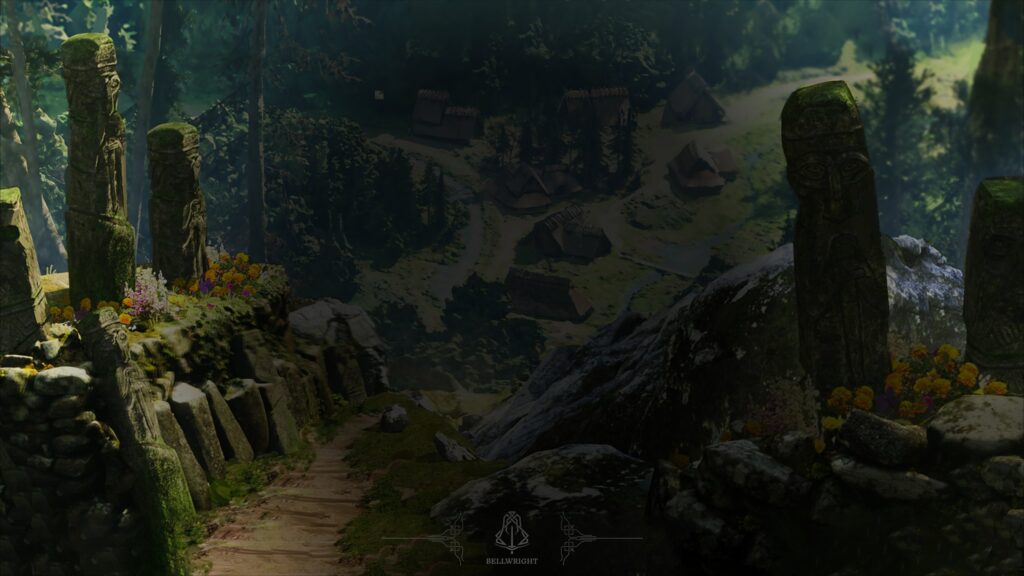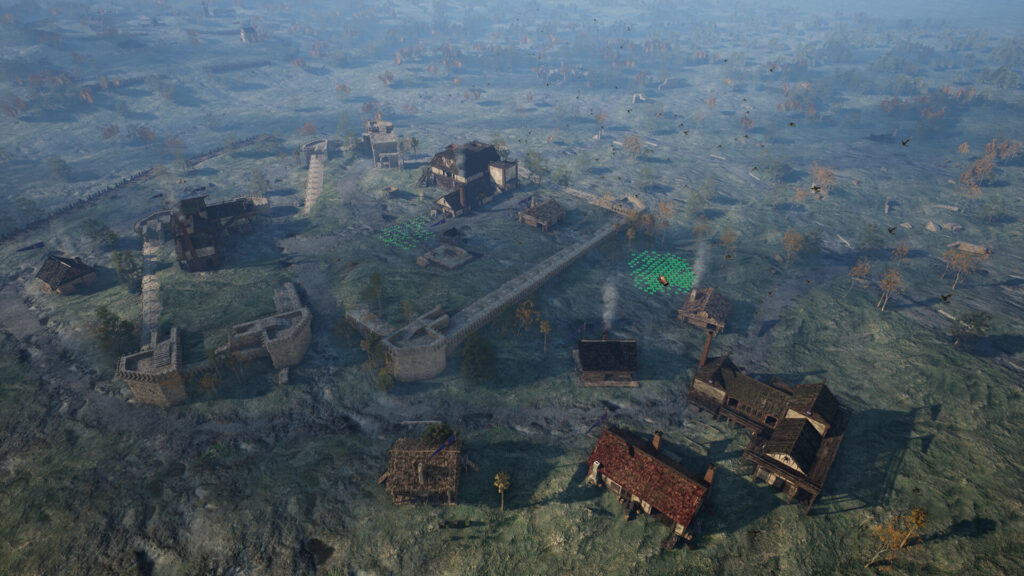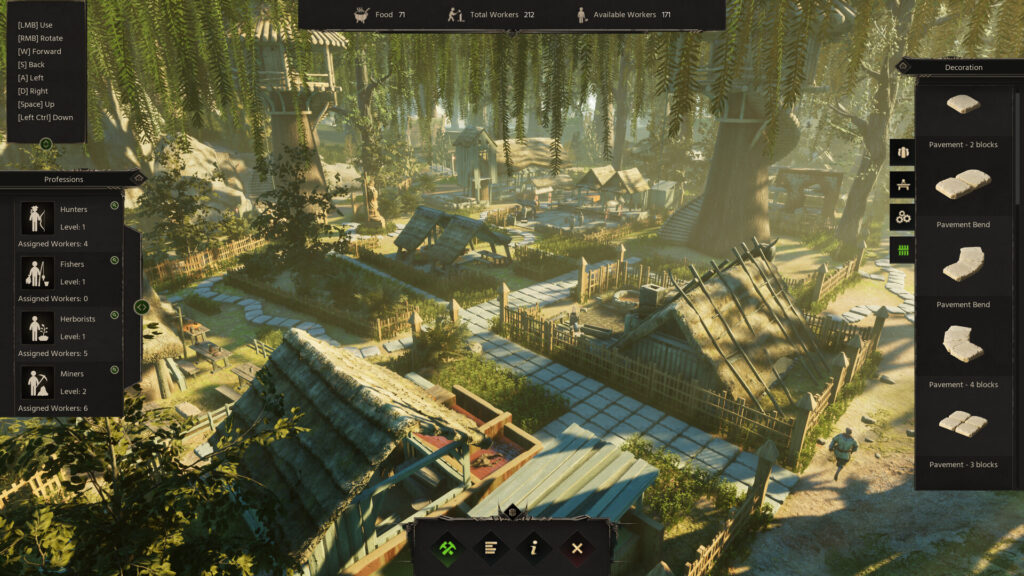Emilija Vuković (University of Belgrade)
This paper delves deeper into the construction of medieval atmosphere within video games, moving beyond the common setting (Bellwright, 2024; Kingmakers, 2024; Robin Hood, 2021). We examine how these games utilize visual elements and cognitive processes to craft unique sensory experiences of the medieval period. Specifically, we will explore how developers leverage the interplay between natural environments and architectural design to shape players’ overall perception of each game world.

Visual perception is a crucial factor, far from a passive process. Our brains function as complex cognitive systems, constantly interpreting and integrating diverse visual cues to construct a coherent understanding of the surrounding environment. Visual reasoning necessitates the brain to reconcile these interpretations and arrive at a definitive conclusion.
Shifting focus to the specific PC games, Kingmakers prioritizes architectural details while neglecting the natural environment, treating it as a secondary consideration. This results in a depiction of nature that lacks depth and fails to capture the historical significance of the medieval landscape. Consequently, Kingmakers’ disregard for the natural world could potentially mislead players into perceiving the medieval era as one where nature played a less prominent role.

Conversely, Bellwright presents a seemingly realistic portrayal of nature. Sunlight filters through meticulously rendered tree canopies, individual leaves are carefully detailed, and the intricate landscapes evoke comparisons to the works of John Constable. This level of detail extends to the game’s architecture as well. This approach has the potential to enhance players’ cognitive and perceptual experience of the medieval era by fostering a sense of immersion that aligns with realistic depictions. In Robin Hood, the environment – encompassing both nature and architecture (e.g., the juxtaposition of ancient oaks and the starry sky) – is rendered in a dramatic fashion. This fosters a sense of wonder and encourages players to engage with the setting in a more mystical way.

In conclusion, video games can evoke a sense of medieval immersion through various cognitive-visual approaches. These approaches range from neglecting the environmental significance, to presenting a realistic medieval world, or employing fantastical elements. All three approaches reflect distinct aesthetic choices within the medieval video game genre.

Bellwright and Robin Hood look stunning! Thanks for bringing them up.
Could you tell us how (or if) the visuals have been integrated with narrative and/or gameplay choices? Does nature work, within these games, as a locus of resources? An antagonistic force? Something to be protected?
In Bellwright, nature is likely integrated as part of the settlements. Additionally, there are scenes showcasing butterflies and flowers, hinting at the significance of nature and the environment. Furthermore, there are depictions that portray the connection between humans and nature.
In Robin Hood and Kingmakers, nature seems to be viewed as part of the settlements also, suggesting it’s likely considered important and something to be defended as part of their property.
Here is a Bellwright photo: https://fileport.io/3HXUUJ265CzJ
Thank you very much for your comment!
Kind Regards!
Thanks for introducing me to these games Emilija! Is it easier for games with detailed graphics to engage with the natural world in this way? Or can you achieve a similar effect with less fidelity?
I believe that games with less graphics can achieve a similar, and perhaps even better, effect. It’s all about creativity! I’m thinking of the work of Eyvind Earle, a Disney illustrator who achieved incredible effects in his animations with very little realism.
Take a look for example:
https://www.waltdisney.org/walt-disney
Thank you for your question. Best regards
Thanks Emilija, great stuff!
Great paper, Emilija! Something that comes to my mind is how the game’s genre heavily influences its visual style and level design. Kingmakers looks like Civilization and other old-school strategy games, which often regard in-game environment as loosely tied to in-game cultures. Conversely, Bellwright’s in-game nature being a more essential gameplay and narrative element is unsurprising given its RPG mechanics. What do you think of my assessment?
Thank you very much for your comment. I think the question is very well put. I also think that strategy games pay less attention to nature, while games like Bellwright have a different visual narrative. Still, I don’t think that has to be the case. It’s all about creativity!
One thing that was raised when we discussed this topic in the third Coding Medieval Worlds workshop in 2023 was the role of semi-natural and human-influenced space. In your examples, one seems as you say very sparse and nature-minimalist, but Bellwright almost looks nature-maximalist, which I think is also an aesthetic that loses some bits of medieval life. Having e.g. a village with forest right up to the edges is very rare in the real world, because pastures or arable are needed to sustain the population, and an “inhabited” forest itself will often be maintained to some extent with coppicing and pollarding, industries like charcoal burning, and so on.
In other words, rather than seeing the style of aesthetics in Bellwright (which I’ve not yet played) as aiming at realism, could we see them more as being part of a natural-ist aesthetic which focuses on closeness to nature and a use of extensive wilderness at the explicit expense of a realist viewpoint? This I think supports your idea of it encompassing a more mystical sense of the medieval and imagining it as being in some way closer to a “natural” state of being (not an uncommon trope and one which of course has had many problems in certain modern hands).
I agree that perceptions of the Middle Ages can be distorted (and more research into archaeological landscapes should be incorporated into the representation of medieval environments). However, I believe that a more realistic nature encourages thinking about the medieval period as a lived, existing period (in contrast to strategy games) at the level of cognitive processing for children and observers unfamiliar with the medieval era. The question is how much we can truly determine, even in serious scientific research, to understand real medieval landscapes. Thank you for the great comment!! Kind Regards.
Thanks for this paper! I find it interesting that it links up in some ways with my own work on audio – I will look further into some of these games, as I’d be interested to know how the audio in them might help or hinder the player in perceiving the natural landscape.
Thank you so much for the wonderful comment. It is beautiful that you are into music, I read your work which is inspiring. For example, I find the combination of medieval times, nature and magic in the Harry Potter game, in the Herbology class, to be very interesting. See for example https://m.youtube.com/watch?v=N1__5gKITsk&pp=ygUbSGFycnkgcG90dGVyIGdhbWUgcGMgcmFiYml0. Also, the music of the Academy of Magic https://m.youtube.com/watch?v=4LSL_nUMtx4&pp=ygUVTWFnaWMgQWNhZGVteSBwYyBnYW1l is very interesting, where nature is wonderfully depicted. In film animation, for example, composer Bruno Kule does this very well https://m.youtube.com/watch?v=iFGSJPRGmT4&pp=ygULd29sZndhbGtlcnM%3D! Best Wishes.